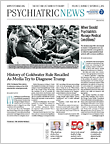I must admit I always feel a little wary when giving a radio interview and questions are being called in by the public. I wait, wondering what’s next and hoping I can be helpful. In fact, calls are usually from individuals with questions about how to best help themselves or their loved ones. Not that these calls are easy to handle on the air, like the one a few years ago from a mother of a suicidal adolescent who clearly needed an emergency department evaluation.
But then it happened. “Hello, my name is Joe, and I’m calling from Oregon.” After the warm greeting, his tone changed, as he sharply questioned how psychiatrists could support a barbaric treatment such as ECT. I did my best to counter with information about the evidence for its safety and life-saving effects, explaining that this excellent treatment was often vilified unjustly. I do not believe Joe was convinced.
Not one week later, I was pleasantly surprised to receive an invitation from Robert M. Califf, M.D., commissioner of the Food and Drug Administration (FDA). The invitation was to participate in the FDA’s stakeholder listening session as this issue of Psychiatric News went to press. The goal is to provide APA and other thought leaders with the opportunity to bring burning issues to the attention of the FDA.
I should note that there were several sources of surprise to me with regard to this invitation—perhaps the most salient one was the notion that a major federal agency would use some of the same strategies that we use in global mental health (GMH) research. Community-based participatory research in GMH settings employs focus groups and other community-engagement approaches to ensure that the research design ultimately is informed by the viewpoints of key stakeholders. The idea is that the research design does not come from “on high” but rather is a product of a close collaboration with the community and local agencies and universities. This strategy promotes not only “buy in,” but optimally “want in.” Similarly, the FDA is clearly seeking to engage those of us most affected by its decisions—patients and their families, physicians, and health care delivery services—to maximize the likelihood that its policies will take into account the nuances of the “real world” and ultimately be better received.
Given Joe’s call, it will not shock you that the APA administration and I selected support for the FDA’s proposed rule change to reclassify ECT devices from Class III (high risk) to Class II (low risk) as a key item to discuss. We will talk with the FDA about the utility and safety of ECT and the need to enhance its availability, injecting robust data into the debate. But ECT is only one of the topics that we will raise with the FDA. We will also encourage a review of prescription practices in view of the opioid epidemic and underscore the need for ensuring diversity in clinical-trial samples to generate data applicable to the diverse U.S. population.
Now, I don’t know if Joe will be at the FDA hearing, and even if he were, I am not sure he would be convinced. But what I do know is that we need to be persistent in adhering to the dissemination of the best data available about treatments that work, treatments that save lives. ■

